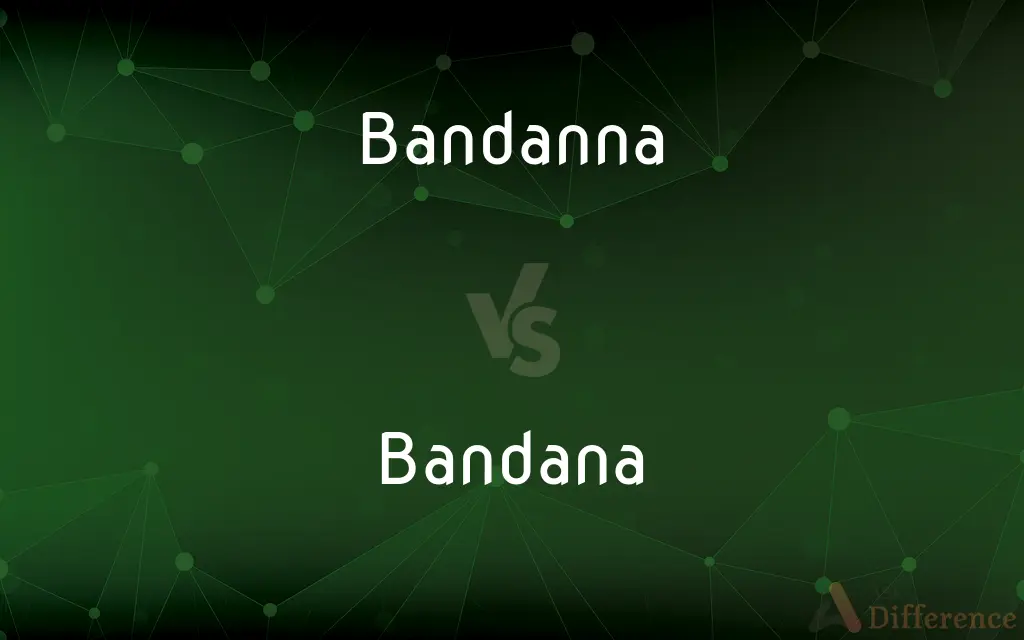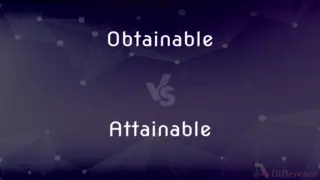Bandanna vs. Bandana — What's the Difference?
By Tayyaba Rehman & Fiza Rafique — Updated on March 17, 2024
Bandanna is a large, brightly colored handkerchief, typically featuring intricate patterns, while Bandana is a variant spelling less commonly used but refers to the same item.

Difference Between Bandanna and Bandana
Table of Contents
ADVERTISEMENT
Key Differences
Bandannas are traditionally square cloths with distinct patterns, often used as neck or headwear. They have historical significance in various cultures, serving both functional and fashion purposes. Whereas, bandanas, with their variant spelling, encompass the same range of uses—from accessories in fashion to practical applications in work environments, emphasizing their versatility and cultural adaptability.
While bandannas often feature paisley patterns, symbolizing a rich cultural heritage from South Asia, bandanas might be found in a wider array of designs, including solid colors and thematic prints. This variety makes them adaptable to numerous stylistic preferences and purposes, from personal expression to group identification.
The term "bandanna" is considered the traditional spelling, reflecting its etymological roots from Hindi and Urdu, linked to the term "bāndhnū," meaning to tie. On the other hand, "bandana" is a more modern adaptation of the spelling, prevalent in American English, which signifies the same object but caters to a streamlined linguistic evolution.
In terms of manufacturing, bandannas are typically made from cotton, silk, or other natural fibers, ensuring breathability and comfort when worn. Meanwhile, bandanas might also be produced from a variety of materials, including synthetic fabrics, offering durability and ease of maintenance for a wide range of activities.
Despite their slight spelling differences, both bandannas and bandanas play significant roles in fashion, workwear, and social movements. They are symbols of resilience, identity, and community, transcending their simple function as a piece of cloth to become iconic elements of style and statement.
ADVERTISEMENT
Comparison Chart
Spelling
Traditional spelling, emphasizing its etymological roots.
Variant spelling, more common in American English.
Patterns
Often features intricate, paisley patterns.
May include a wider variety of designs, including thematic prints and solid colors.
Origin
Derives from Hindi and Urdu, linked to "bāndhnū" (to tie).
A modern adaptation, reflecting the item's cultural integration.
Material
Traditionally made from cotton, silk, or other natural fibers.
Can be made from both natural and synthetic fabrics.
Usage
Serves both functional and fashion purposes, deeply rooted in cultural significance.
Adaptable for fashion, work, and symbolic uses, reflecting personal and group identity.
Compare with Definitions
Bandanna
A versatile piece of fabric used in fashion, workwear, and as a symbolic gesture.
The bikers coordinated their look with matching bandannas.
Bandana
A symbol of identity and group belonging, used in many social movements.
The protestors wore purple bandanas to signify their unity.
Bandanna
A large, square piece of cloth, often brightly colored and patterned, used as a head or neck covering.
She wore a red bandanna to keep her hair back.
Bandana
Adaptable for multiple uses, from a stylish accessory to a functional piece of workwear.
She used her bandana as a makeshift mask when dust rose on the trail.
Bandanna
A traditional accessory with cultural significance in various communities.
The bandanna he wore symbolized his heritage.
Bandana
Often made from durable materials, suitable for both work and play.
His synthetic bandana was easy to wash after a day of hiking.
Bandanna
A garment made from natural fibers like cotton or silk, prioritizing comfort.
His silk bandanna was both a stylish and practical choice for the summer.
Bandana
A variant spelling of bandanna, referring to a similar square cloth used for various purposes.
He tied the bandana around his neck to protect against the sun.
Bandanna
An item featuring distinctive, often paisley, patterns.
The intricate pattern on her bandanna caught everyone's eye.
Bandana
A fashion accessory that comes in various designs, including solid colors and prints.
Her bandana matched her outfit perfectly, adding a pop of color.
Bandanna
A large handkerchief usually patterned and brightly colored.
Bandana
A large handkerchief usually patterned and brightly colored.
Bandanna
Alternative spelling of bandana
Bandana
A large kerchief, usually colourful and used either as headgear or as a handkerchief, neckerchief, bikini, or sweatband.
Bandanna
A species of silk or cotton handkerchief, having a uniformly dyed ground, usually of red or blue, with white or yellow figures of a circular, lozenge, or other simple form; - it is often used as a neckerchief. The term is also used for any large and brightly colored handkerchief.
Bandana
A style of calico printing, in which white or bright spots are produced upon cloth previously dyed a uniform red or dark colour, by discharging portions of the color by chemical means, while the rest of the cloth is under pressure.
Bandanna
Any scarf worn on the neck or head, usually of large size.
Bandana
Large and brightly colored handkerchief; often used as a neckerchief
Bandanna
A style of calico printing, in which white or bright spots are produced upon cloth previously dyed of a uniform red or dark color, by discharging portions of the color by chemical means, while the rest of the cloth is under pressure.
Bandanna
Large and brightly colored handkerchief; often used as a neckerchief
Common Curiosities
Are bandannas only used for fashion?
No, they serve both functional and fashion purposes and have cultural significance.
What is a bandanna?
A large, square piece of cloth, often brightly colored and patterned, used for various purposes.
Do bandannas and bandanas come in different sizes?
Typically, they are large and square, but sizes can vary depending on the purpose.
Is there a difference in patterns between bandannas and bandanas?
Bandannas often feature paisley patterns, while bandanas can include a wider variety of designs.
Are bandanas used in social movements?
Yes, they can symbolize identity and unity in various social movements.
Can bandanas be used as headbands?
Yes, they are often folded and tied as headbands.
How does a bandana differ from a bandanna?
Bandana is a variant spelling of bandanna, but both refer to the same item.
Can a bandanna be used as a protective garment?
Yes, it can be used to protect against sun, dust, and other elements.
Can bandanas be made from synthetic materials?
Yes, bandanas can be made from both natural and synthetic fabrics.
What is the origin of the term bandanna?
It derives from Hindi and Urdu, linked to the term "bāndhnū," meaning to tie.
Can both men and women wear bandannas?
Yes, bandannas are both gender and can be worn by anyone.
Is the spelling "bandana" more common in certain regions?
Yes, "bandana" is more common in American English.
How do you clean a bandanna or bandana?
Washing instructions vary, but many can be machine washed or hand washed.
Are bandannas suitable for outdoor activities?
Yes, they are popular in outdoor and work settings for their functionality.
Do bandannas only come in paisley patterns?
While paisley is traditional, bandannas can feature various patterns and designs.
Share Your Discovery

Previous Comparison
Psalms vs. Psalm
Next Comparison
Obtainable vs. AttainableAuthor Spotlight
Written by
Tayyaba RehmanTayyaba Rehman is a distinguished writer, currently serving as a primary contributor to askdifference.com. As a researcher in semantics and etymology, Tayyaba's passion for the complexity of languages and their distinctions has found a perfect home on the platform. Tayyaba delves into the intricacies of language, distinguishing between commonly confused words and phrases, thereby providing clarity for readers worldwide.
Co-written by
Fiza RafiqueFiza Rafique is a skilled content writer at AskDifference.com, where she meticulously refines and enhances written pieces. Drawing from her vast editorial expertise, Fiza ensures clarity, accuracy, and precision in every article. Passionate about language, she continually seeks to elevate the quality of content for readers worldwide.
















































